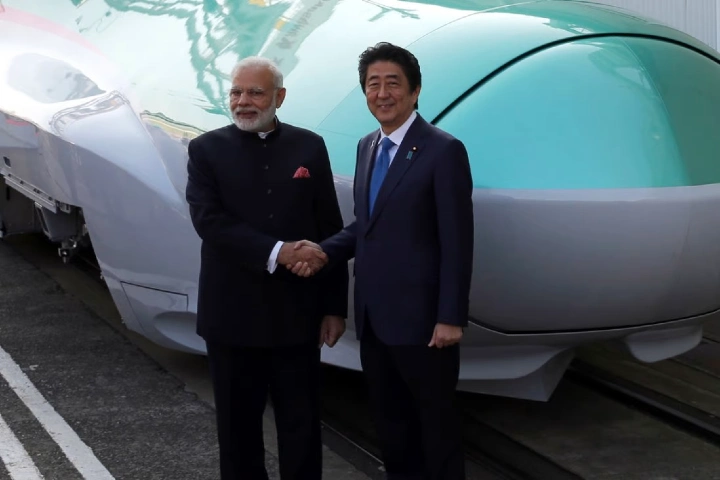Railways in India have always been a harbinger of good times – economically. For those who love to dig history to fathom drivers of economic growth, laying of railway track was the best, most economic and shortest route to prosperity for the region. No wonder that we see even today, the clamour for new lines and new trains from the elected representatives. And they are not wrong. But now a new dimension is emerging in the train and rail dynamics for economic growth. It is a strategy which propels a faster rate of growth, for all that matters is the speed of growth. The era of high speed trains, commonly referred to as bullet trains or Shinkansen has arrived to fuel this speed of progress.
The bullet train is a superheavy investment but it ordains a new world of rail technology. The rail systems that we have are fit up to 200 kmph. As we seek to go beyond 300 kmph the rail technology puts us on a different pedestal. Dedicated and elevated tracks, cab signalling, intelligent remote controls, noise reduction systems, cognisance of wind effects, infotainment, station architecture, passenger car design and train operations, all woven together provide a safe, punctual and a relaxed delightful journey experience. The existing skills won’t work. It has to be a fresh start.
When the country moves to grasp these new frontiers of high speed rail technology the first effect is on economic growth. The Mumbai-Ahmedabad high speed rail link was sanctioned at an initial investment of over 1.1 lakh crore; around 82% funded by very low interest loans. This money will get pumped in a 500 km stretch. What we are witnessing as the construction gathers pace is a sea change in attitude in the way we do our job. New contract standards are being adopted which reduces investment to maturity time along with security to the stakeholders. New rail laying technology is being used to fast forward track laying. All such things invite investment. Since all such skills are tightly held and the performance parameters are demanding, the investments are sizeable and this brings in serious players. The fillip is railways but the shadow effect on industry is enormous. Just to narrate one – the fare collection system and passenger entry to platforms involves a complex IT architecture. It regulates passengers’ entry; provides a medium for observing travel trends and is instantaneous in report generation. Now this mode can easily be transplanted in any other area where similar situations exist e.g. bus terminals, nominated exhibition grounds, sports stadiums and the list can go on. And not to forget the existing railway stations dotted all across the country. Such models are scalable to any level, both at micro and macro levels.
If we assess station designs we observe that train movement is only one component. The station is now a business centre, a mall conglomerate, a convention hub and above all an entertainment destination. The High Speed rail has redefined the station concept. Convert this into economic growth. Moreover, as the time passes the growth shall keep on climbing. To give it an understandable perspective consider the growth at railway station of New Delhi or Chennai or Jaipur. Without railways the makeover would not have been possible. With the advent of High Speed we are knocking at the door of a sustained double digit growth.
High speed connectivity has other dimensions too. Because of dedicated tracks and high acceleration trains, tier 2 towns shall see a major boost in industrial growth. One of the essential ingredients is faster access to a industrial cluster without shifting of the populace. What it translates is a stupendous growth for cities like Anand, Bilimora, Bharuch, Virar, Boisar and Vapi on Mumbai Ahmedabad corridor where the bullet train shall have halts. The new connectivity shall provide a comfortable ‘morning out -evening back’ scenario even to air travellers landing at Mumbai, Ahmedabad, Vadodara or Surat. All other ingredients for economic upsurge being already present, the quick comfortable access of world class standards shall be the everlasting gel.
The experience of spectacular growth has been proven by similar high speed trains in Japan, China and France. Today Tokyo to Osaka Shinkansen sees more footfalls than the airlines as the journey time between the work centres is much less and comes at a much reduced cost as well. Adoption of High Speed travel has brought efficiency in their lives. This gives more time for work and networking. Likewise, the domestic airlines in France are not travellers choice anymore. Up to about 800 kms high speed travel is now a new normal. Even without the first high speed line waiting to take shape, the state governments in India are working on strategies to adopt the same in their domain.
Make in India policy has transformed the Indian economic landscape. When the high speed project started a large number of contracts were assigned to Japanese companies. Within a few years the tables have been turned and a majority of civil contracts are now with Indian Infrastructure companies. And they all qualify the stringent Japanese standards. More is likely to be heard in the signalling and rolling stock domain where the technology has been tightly held by the Japanese firms. The policy of the Modi Government has ensured that Make in India policies not only brings manufacturing to India but also speeds up the same. It is amply evident in the Indian Shinkansen. Being a new technology there are greater opportunities thrown in.
If we recall, advancements in space technology spilled over to the defence arena and then to normal life pumping the economy with applications of new technology. Something similar is likely to happen in the high speed rail sector. The way India, under PM Narendra Modi has started, it shall not be a surprise that there shall be an Indian version of High Speed rail in entirety and the economy shall be adequately revved up for the goal of 5 trillion dollars or even more.
(Arunendra Kumar is the former Chairman of Railway Board, India. Views expressed are personal and exclusive to India Narrative)




















